|
|
|
|
|
|
 Home
> Museum Information > Neighboring Tourist Spot Home
> Museum Information > Neighboring Tourist Spot |
|
| |
|
| |
 |
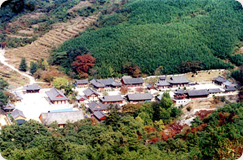 |
The name of temple was given by the state
for commemorating the loyalty of Samyeongdaesa
who performed a meritorious deed during the
Imjin War. It was designated as the seventeenth
monument of Gyeongsangnam-do on 28th, Dec.
1974. This temple has very long history. In
fact, it was established by Wonhyodaesa in
654 A. D and called ‘Jukrimsa’. It is said
that the temple was renovated by an Indian
monk, Hwngmyeonseonsa, in 829 A. D. Hwngmyeonseonsa |
| changed the name
of temple, Jukrimsa into Yeonjeongsa, and
built a three stories pagoda. A relic of the
Buddha was enshrined in the pagoda by him.
In 1839, the name of temple, Yeonjeongsa was
changed into Pyochungsa since Wolpaseonsa,
who was one of the disciples of Samyeongdaesa,
brought the shrine, named Pyochungsa, which
had been made in order to commemorate the
loyalty of Samyeongdaesa in Muanyeon, to this
temple. There are various designated monuments
including one piece of national treasure and
one piece of treasure in this temple. |
|
| |
 |
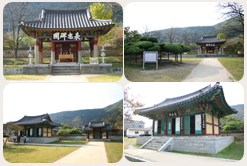 |
It is a stone monument, which is very well
known because it is sweating, built by Nambung,
who was the fifth generation disciple of Samyeongdaesa,
in 1742 in order to commemorate the loyalty
of Samyeongdaesa(1544~1610), who performed
a meritorious deed during the Imjin War. Samyeongdaesa
was a high monk during Seonjo's reign of Joseon
period and his secular name was Yi-hwan Lim.
He raised an army in the cause of justice
when Imjin war had been began and played an
active role |
| under Samyeondasesa and took a lead of the army of monks after Samyeondasesa in Sunan region. He visited to Japan with a king’s message as a delegation and had a meeting with Tokugawa Iyeyas in 1604. In 1605, He came back to Korea along with 3,500 captives from Japan. In the front side of the stone monument, ‘Yumyeongjoseongukmilyangpyochungsasongundaesayeongdangbimyeongseo’ (the title of monumet) was inscribed in the front side of the monument and ‘Pyochungsasajeokgi’ was inscribed in the back side of it, which mentions the life history of Samyeongdaesa and his effort, loyalty and faith for national salvation during Imjin and Jeongyu war.This monument is also called ‘Hanbi’ because water drops, like beads of sweat, naturally appear on the monument’s surface whenever serious national crises were happened. Therefore, local people has believed that it is a kind of miracle made by Samyeongdaesa who is always concerned about nation and people and deified this monument. |
|
| |
 |
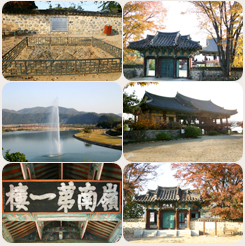 |
This is a pavilion well known as one of
the representative three pavilions of Yeongnam
region, which include Chokseokru in Jinju
and Yeonghoru in Andong. It was built by Kim
Ju, a regional governor in Milyang, in 1465
at the place where there was ruin of Yeonanamsa,
which had been built by King Gyeongdeok (742~765)
in Silla period and called ‘Yeongnamru’. It
is located at the top of cliff beside Milyang
river. It was used as the annex to Milyanggwan
which was a kind of guest house in Milyang
region in Joseon period. The pavilion has
two corridors with stairs which are connected
with two other annex buildings. One can see
beautiful scenery in any directions because
it doesn’t have intercolumnar walls. It has
enough space to hold a party. |
| Although it is
said that the pavilion had been originally
built in the late [of] Goryo period, it was
rebuilt 1844 since it was burnt by fire in
1822. It is a representative architecture
of Joseon period and considered as one of
the most beautiful pavilions in Korea. It
has several annex buildings ; Nungpadang,
Yangikru, Sajumun, Iljumu, Cheonjingung in
which mortuary tablets for the founders of
all dynasties in Korea since Dangun, who is
believed as the progenitor of old Joseon,
are placed, and Aranggak in which Arangnyeo
is worshipped. |
|
| |
 |
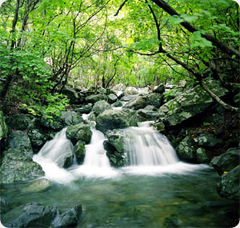 |
This is located in the northern mid-slope
of Jaeyak mountain which is 1189 m above the
sea level and is 36 km east from the Milyang
City Hall. This valley has been well known
as ‘the mystery of Milyang’ because it is
filled with ice during summer and the ice
thaws during winter. Formation of ice begins
from the mid of June and it reaches a peak
during the hottest season. Ice, however, begins
to thaw from the autumn and it becomes water
with steam during winter season. It is so
rare natural phenomenon that it was designated
as 244th of natural monument in 24th, April,
1970 for protection. |
|
| |
 |
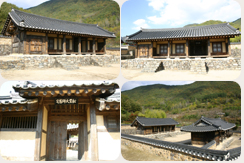 |
Samyeongdaesa, who was the leader of monk
army in the cause of justice during Imjin
War, was born in ‘Im’ family of Pungcheon.
His father is Su-Seong Im, and mother is from
‘Seo’ family in Dalseong. His secular name
is Yu-Jeong or Ung-Gyu and his pennames are
known as Jong-Bong, Song-Un and Sa-Myeong.
He left his home at 13 year old in 1556 and
became a monk under the guidance of Sinmukhwasnag
at Jikjisa. He spent his early days before
becoming monk in this place. Many stories
about his childhood have been handed down
in this area. Samyengdaesa Commemoration Park
is under construction in 2004. |
|
| |
 |
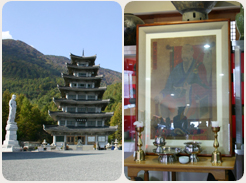 |
There are four stories ‘Beopdang’ (a building
that contains a statue of Buddha), the biggest
bell tower in Korea, and pagoda-shaped seven
stories Seongbo museum in Yeongsanjeongsa.
Besides, the biggest a statue of recumbent
Buddha around 130 m of the world is being
established in Yeongsanjeongsa. This place
is considered as a gateway of Milyang region
because it is 1 km away from Samyengdaesa
Commemorating Park, which is under construction
now, and located in nearby Pyochungsa and
Pyochungbi. |
| Various and valuable Buddhist
artifacts, including the Buddha’s relics,
from all over the world are displayed in the
museum and those artifacts captivate Buddhists’
attention. The head monk of Daegaksa in Busan
has collected the relics of Buddha, which
are considered as the crystallized result
of the Buddha’s practice of austerities, during
last forty years from all over the world and
gives visitors a chance to see the relics. |
|
|
|
|
|
